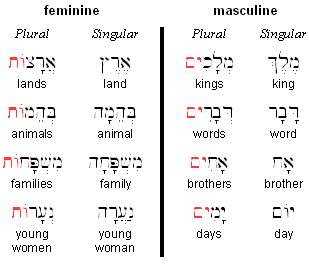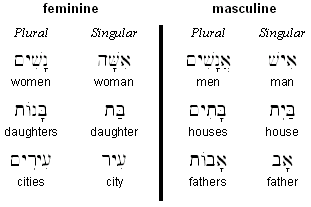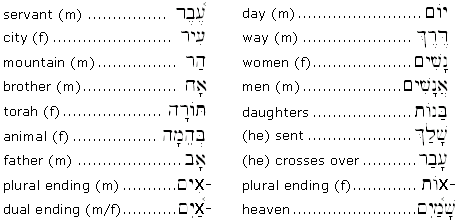|
Hebrew Plural Nouns
Like English, Hebrew nouns can be either singular or plural in number. In English, plural forms of a noun are normally formed by adding "-s" or "-es" to the end of the singular form of the word (for example, cars, boxes). In Hebrew, nouns are made plural by adding  or or  to the end of a singular noun. Often there are vowel changes that occur when these endings are added, since an extra syllable is added to the word. to the end of a singular noun. Often there are vowel changes that occur when these endings are added, since an extra syllable is added to the word.
Plural Noun Endings
Sometimes it helps to see patterns in the way words are formed. These patterns are sometimes called inflections. For Hebrew plural nouns, the pattern looks like this:

The table above shows typical (or "regular") endings for plural nouns. For masculine plural nouns,  is added to the base stem of the word; for feminine is added to the base stem of the word; for feminine  is added. is added.
You can see how the patterns appear in the following examples:

Notice in the list above that the feminine plural nouns end in  , but the masculine nouns end in , but the masculine nouns end in  . All of these nouns are "regularly formed," meaning that there are consistent changes made to the vowels when the endings are added (more information about vowel changes is provided below). . All of these nouns are "regularly formed," meaning that there are consistent changes made to the vowels when the endings are added (more information about vowel changes is provided below).
Irregular Plural Nouns
Some Hebrew nouns do not follow the standard pattern when forming their plural. These cases of noun are sometimes called "irregular," since they are not the usual form you might expect (English also has irregular plural forms, for example, the plural of foot is feet, or the plural of child is children). In the case of irregular Hebrew plurals, you simply have to memorize the forms.
Here are some examples of irregular plural noun forms:

Notice that the plural for woman (nashim) shows a Nun infix and a masculine plural ending. The Nun infix also appears in the plural of man (anashim) and in the plural for daughter (banot). The word for fathers (avot) is masculine even though it has the feminine plural ending. The word for cities (irim) and women (nashim) are feminine, even though they show a masculine plural ending. It's important to keep this is mind, since adjectives and verbs must agree with the nouns they modify in gender and number.
3rd Person Plural Verb Forms
In Hebrew, Plural nouns must take a plural verb form. The vowel pattern for the three letter shoresh (root) of a (Qal perfect) verb in the third person plural is:

Note that this pattern is used for both masculine and feminine plural (i.e., common gender plural) subjects. Here are some examples of the pattern:

"Dual" Nouns
Some nouns form their plural using a "dual" form. This form is used most often to indicate a pair of something (eyes, hands, feet, and ears) that come in pairs. It is also used to denote undifferentiated plurality (e.g., heaven, water).

Notice that this ending is similar to the regular plural ending for masculine nouns, though it is actually a diphthong with the accent over the patach (pronounced ayim). Note also that both masculine and feminine "dual" nouns use the same ending.

Summary Chart: Noun Endings
Keeping in mind that some masculine nouns take feminine plural endings (e.g., avot) and some feminine nouns take masculine plural endings (e.g., nashim), the following chart summarizes the most common noun endings encountered in Biblical Hebrew:

The lexical form of a word is the spelling of the word as it appears in a dictionary. Be advised that the lexical form of a word is always the singular spelling. For example, suppose you see the word nashim and wish to look it up in a Hebrew dictionary. You will need to remember that the singular form of nashim is actually isha and then look up the entry there!
Because of this, I recommend that when first learning a new noun, write out a flash card with the gender, singular form, plural form and the construct form on the front, and the definition on the back.
Section Exercises
- Memorize the section vocabulary (top of the page)
- Memorize the noun endings table
- Understand that some nouns use irregular noun endings
<< Return
|











